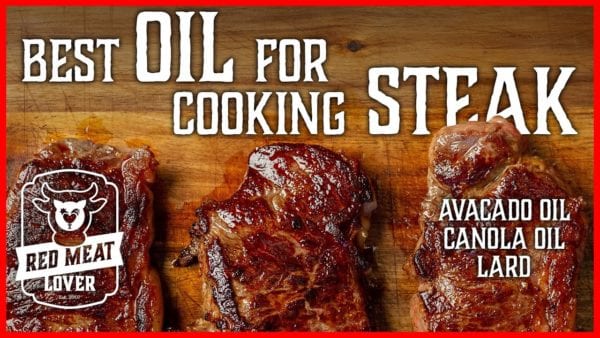In this video, we show you a how to cook steak on the stove experiment using different types of oil – Lard, Canola Oil, and Avocado Oil. We talk about smoke points of different oils and explore what impact the oil has on the finished steak. This is a tasty experiment that you won’t want to miss!
What is “Smoke Point”?
Smoke point, also known as burning point, is the temperature where the oil begins to smoke. More importantly, it will leave your food with a bitter taste and your kitchen filled with tear inducing, stinky smoke.
Why didn’t we add butter for this experiment? Butter has a very low smoke point (at around 300 degrees Fahrenheit) so it is not the best option for searing steaks. However, the exception is clarified butter, also known as ghee, which has a much higher smoke point than regular butter.
How to Cook Strip Steak
For this experiment, we used choice grade strip steaks, which we hand cut ourselves from a large loin. It’s an easy thing that you can do yourself right at home and it will save you a lot of money on steaks. We have a video designated with instructions on how to break down a whole beef loin.
The steaks that we are using are about 1.25 inches thick. They have already been salted with .5 tablespoon of kosher salt. We want to keep things consistent so that we can really measure the outcome across all methods. Also, we really wanted to isolate the impact of the oil on the steak so we are only using oil, steak and salt. That’s it! No extra seasonings. We recently did an experiment on what’s the best time to season steak and found that the best results happen when the steak is salted and rested at least an hour before cooking.
You may be wondering-how do I get a beautiful sear on my steak? Well, you want to make sure your pan is HOT. Not just kinda, sorta hot. You want it to be HOT HOT (but not too hot that you burn your steaks, find that sweet spot). We recommend investing in an infrared thermometer to check your pan temperature and using a cast iron skillet for the best sear.
Lard aka “Meat Nectar”
- Smoke point: 374 degrees Fahrenheit. The lowest smoke point of the three oils tested in this experiment.
- How’d it sear? Had the most amount of burnt edges as compared to the other two oils.
- Flavor: Nothing really stands out about the steak. We don’t really have much to report in terms of the impact of the lard on the flavor or the texture.
Canola Oil
- Smoke point: 426-444 degrees Fahrenheit.
- How’d it sear? Created a nice sear with a little bit of burnt edges.
- Flavor: We taste a little bit more of the canola oil, which almost has a vegetable oil type of flavor. It is subtle. It’s not robust.
Avocado Oil
- Smoke point: a whopping 520 degrees Fahrenheit.
- How’d it sear? It created really nice crust, it’s uniform end to end for the most part and almost no black or burnt exterior at all.
- Flavor: This has the best flavor. It really adds to the richness to the steak.
So, What’s the Best Oil?
In conclusion, the avocado oil added the best sear and best flavor to the strip steak. We recommend using avocado for all of your cooking steak needs. The only con to using avocado oil is that it can be a little costly. But it’s totally worth the flavor!
We invite you to discover for yourself what works best, for not only your palette but your pocketbook as well. If you liked this experiment, please go ahead and subscribe to our YouTube channel so we can continue cooking meat, made easy!
Ingredients
|

|
- 1 hour before cooking, season steak with salt and let come to room temperature.
- Heat your cast iron skillet on HIGH.
- Drop oil into pan and let heat up.
- Carefully lay steak into pan and let cook for 2-3 minutes on each side.
- Use a thermometer to check the internal temperature of the steak. Remove steak when it reaches your preferred temperature of doneness.
- Let rest for 5 minutes before eating.
This recipe is for experimenting with the different flavor profiles of oils. If you want to add more flavor, we recommend seasoning your steak with your favorite steak rub and adding butter and fresh rosemary to the pan while the steak cooks.


